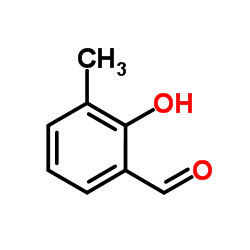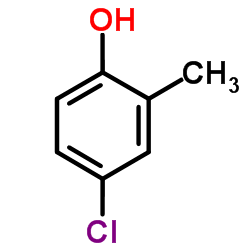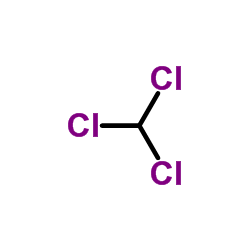5-chloro-2-hydroxy-3-methylbenzaldehyde

5-chloro-2-hydroxy-3-methylbenzaldehyde structure
|
Common Name | 5-chloro-2-hydroxy-3-methylbenzaldehyde | ||
|---|---|---|---|---|
| CAS Number | 23602-63-3 | Molecular Weight | 136.148 | |
| Density | 1.2±0.1 g/cm3 | Boiling Point | 207.9±20.0 °C at 760 mmHg | |
| Molecular Formula | C8H8O2 | Melting Point | 67 °C | |
| MSDS | N/A | Flash Point | 82.3±14.4 °C | |
| Name | 5-chloro-2-hydroxy-3-methylbenzaldehyde |
|---|---|
| Synonym | More Synonyms |
| Density | 1.2±0.1 g/cm3 |
|---|---|
| Boiling Point | 207.9±20.0 °C at 760 mmHg |
| Melting Point | 67 °C |
| Molecular Formula | C8H8O2 |
| Molecular Weight | 136.148 |
| Flash Point | 82.3±14.4 °C |
| Exact Mass | 136.052429 |
| PSA | 37.30000 |
| LogP | 2.07 |
| Vapour Pressure | 0.2±0.4 mmHg at 25°C |
| Index of Refraction | 1.602 |
Synonym: Section 2 - COMPOSITION, INFORMATION ON INGREDIENTS
Risk Phrases: 36/37/38 Section 3 - HAZARDS IDENTIFICATION EMERGENCY OVERVIEW
Irritating to eyes, respiratory system and skin.Air sensitive.Moisture sensitive. Potential Health Effects Eye: Causes eye irritation. Skin: Causes skin irritation. May be harmful if absorbed through the skin. Ingestion: May cause irritation of the digestive tract. May be harmful if swallowed. Inhalation: Causes respiratory tract irritation. May be harmful if inhaled. Chronic: Not available. Section 4 - FIRST AID MEASURES Eyes: Flush eyes with plenty of water for at least 15 minutes, occasionally lifting the upper and lower eyelids. Get medical aid. Skin: Get medical aid. Flush skin with plenty of water for at least 15 minutes while removing contaminated clothing and shoes. Ingestion: Get medical aid. Wash mouth out with water. Inhalation: Remove from exposure and move to fresh air immediately. If not breathing, give artificial respiration. If breathing is difficult, give oxygen. Get medical aid. Notes to Physician: Treat symptomatically and supportively. Section 5 - FIRE FIGHTING MEASURES General Information: As in any fire, wear a self-contained breathing apparatus in pressure-demand, MSHA/NIOSH (approved or equivalent), and full protective gear. Extinguishing Media: Use water spray, dry chemical, carbon dioxide, or chemical foam. Section 6 - ACCIDENTAL RELEASE MEASURES General Information: Use proper personal protective equipment as indicated in Section 8. Spills/Leaks: Vacuum or sweep up material and place into a suitable disposal container. Section 7 - HANDLING and STORAGE Handling: Avoid breathing dust, vapor, mist, or gas. Avoid contact with skin and eyes. Storage: Store in a cool, dry place. Store in a tightly closed container. Store under nitrogen. Section 8 - EXPOSURE CONTROLS, PERSONAL PROTECTION Engineering Controls: Facilities storing or utilizing this material should be equipped with an eyewash facility and a safety shower. Use adequate ventilation to keep airborne concentrations low. Exposure Limits CAS# 23602-63-3: Personal Protective Equipment Eyes: Not available. Skin: Wear appropriate protective gloves to prevent skin exposure. Clothing: Wear appropriate protective clothing to prevent skin exposure. Respirators: Follow the OSHA respirator regulations found in 29 CFR 1910.134 or European Standard EN 149. Use a NIOSH/MSHA or European Standard EN 149 approved respirator if exposure limits are exceeded or if irritation or other symptoms are experienced. Section 9 - PHYSICAL AND CHEMICAL PROPERTIES Physical State: Solid Color: tan Odor: Not available. pH: Not available. Vapor Pressure: Not available. Viscosity: Not available. Boiling Point: Not available. Freezing/Melting Point: 69 - 70 deg C Autoignition Temperature: Not available. Flash Point: Not available. Explosion Limits, lower: Not available. Explosion Limits, upper: Not available. Decomposition Temperature: Solubility in water: Specific Gravity/Density: Molecular Formula: C8H7ClO2 Molecular Weight: 171 Section 10 - STABILITY AND REACTIVITY Chemical Stability: Not available. Conditions to Avoid: Incompatible materials, moisture, exposure to air, contact with water. Incompatibilities with Other Materials: Oxidizing agents. Hazardous Decomposition Products: Hydrogen chloride, chlorine, carbon monoxide, carbon dioxide, acrid smoke and fumes. Hazardous Polymerization: Has not been reported Section 11 - TOXICOLOGICAL INFORMATION RTECS#: CAS# 23602-63-3 unlisted. LD50/LC50: Not available. Carcinogenicity: 5-Chloro-2-hydroxy-3-methylbenzaldehyde - Not listed by ACGIH, IARC, or NTP. Section 12 - ECOLOGICAL INFORMATION Section 13 - DISPOSAL CONSIDERATIONS Dispose of in a manner consistent with federal, state, and local regulations. Section 14 - TRANSPORT INFORMATION IATA No information available. IMO No information available. RID/ADR No information available. Section 15 - REGULATORY INFORMATION European/International Regulations European Labeling in Accordance with EC Directives Hazard Symbols: XI Risk Phrases: R 36/37/38 Irritating to eyes, respiratory system and skin. Safety Phrases: S 26 In case of contact with eyes, rinse immediately with plenty of water and seek medical advice. S 37/39 Wear suitable gloves and eye/face protection. WGK (Water Danger/Protection) CAS# 23602-63-3: No information available. Canada None of the chemicals in this product are listed on the DSL/NDSL list. CAS# 23602-63-3 is not listed on Canada's Ingredient Disclosure List. US FEDERAL TSCA CAS# 23602-63-3 is not listed on the TSCA inventory. It is for research and development use only. SECTION 16 - ADDITIONAL INFORMATION N/A |
| Hazard Codes | Xi |
|---|---|
| Risk Phrases | R36/37/38 |
| Safety Phrases | S26-S36/37/39 |
| HS Code | 2913000090 |
|
~60% 
5-chloro-2-hydr... CAS#:23602-63-3 |
| Literature: PHARMACIA CORPRATION Patent: WO2004/60376 A1, 2004 ; Location in patent: Page/Page column 181 ; |
|
~61% 
5-chloro-2-hydr... CAS#:23602-63-3 |
| Literature: Nagarajan, Srinivasan R.; Devadas, Balekudru; Malecha, James W.; Lu, Hwang-Fun; Ruminski, Peter G.; Rico, Joseph G.; Rogers, Thomas E.; Marrufo, Laura D.; Collins, Joe T.; Kleine, H. Peter; Lantz, Melissa K.; Zhu, Jun; Green, Nawasa F.; Russell, Mark A.; Landis, Bryan H.; Miller, Lawrence M.; Meyer, Debra M.; Duffin, Tiffany D.; Engleman, V. Wayne; Finn, Mary B.; Freeman, Sandra K.; Griggs, David W.; Williams, Melanie L.; Nickols, Maureen A.; Pegg, Jodi A.; Shannon, Kristen E.; Steininger, Christina; Westlin, Marisa M.; Nickols, G. Alan; Keene, Jeffery L. Bioorganic and Medicinal Chemistry, 2007 , vol. 15, # 11 p. 3783 - 3800 |
|
~% 
5-chloro-2-hydr... CAS#:23602-63-3 |
| Literature: European Journal of Medicinal Chemistry, , vol. 31, # 6 p. 449 - 460 |
| Precursor 4 | |
|---|---|
| DownStream 0 | |
| HS Code | 2913000090 |
|---|---|
| Summary | HS: 2913000090 halogenated, sulphonated, nitrated or nitrosated derivatives of products of heading 2912 Educational tariff:17.0% Tax rebate rate:9.0% Regulatory conditions:none Most favored nation tariff:5.5% General tariff:30.0% |
| 3-Methyl-5-chlor-salicylaldehyd |
| 2-hydroxy-3-methyl-5-chlorobezaldehyde |
| 3-methyl-5-chloro-2-hydroxybenzaldehyde |
| 5-Chloro-2-hydroxy-3-methyl-benzaldehyde |
| 2-Hydroxy-3-methylbenzaldehyde |
| 2-hydroxy-3-methyl-5-chlorobenzaldehyde |
| 5-chloro-3-methylsalicylaldehyde |
| 5-chloro-3-methyl-2-hydroxybenzaldehyde |
| MFCD00275687 |
| Benzaldehyde, 2-hydroxy-3-methyl- |



